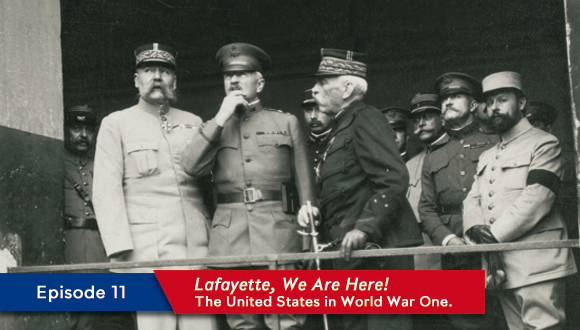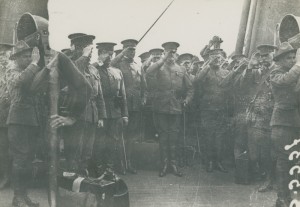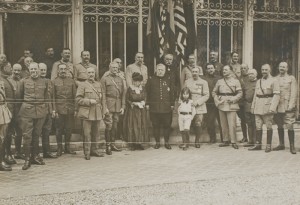
In the Cour d’Honneur of the Hotel des Invalides, 23 June 1917. © Paris musée de l’Armée, dist. RMN-GP image musée de l’Armée
The First U.S. Troops Arrive in France
Major General “Black Jack” Pershing lands in France
General of the Armies John Joseph “Black Jack” Pershing (1860-1948) was Major General when the United States declared war against the German Empire. Following the sudden death of Major General Frederick Funston (1865-1817) Secretary of War Newton D. Baker appointed Pershing as the American Expeditionary Forces commander. On 13 June 1917, Major General Pershing, Captain George Patton (1885-1945) and 177 Americans soldiers landed at Boulogne-sur-Mer, amidst a jubilant crowd. Pershing’s instructions were clear: form an independent standing army and complete the training of the units started in America in the French zone of operations, under French.
The Amalgamation Controversy
Despite the Joffre-Baker Agreement signed on 14 May 1917 (see episode 8), the French as well as the British kept on trying to amalgamate the American forces into their respective armies as security assistance. In December 1917, following the wave of pacifism stimulated by the Russian Revolution, General Pétain was heard saying “I am waiting for tanks and the Americans”. General Pershing and the U.S. Government were totally against it for reasons that can be easily understood, America’s fight for Independence on the international arena to protect both national interest and distinct strategy and tactics. From the start, General Joffre was favourable to this idea which he had backed up during the discussions that led to the Joffre-Baker Agreement – Georges Clémenceau who opposed General Joffre’s position forbade him to interfere with the Americans. Although relations between US and French Armies’ High Command were often tense, General Pershing succeeded in joining the Allied Supreme Command formed by the French and the British. In 1918, General Pershing supported General Foch’s appointment as Allied Supreme Commander.
After the Armistice, General Pershing continued his work on the restructuration of the U.S. Army. In 1919, the U.S. Congress authorized President Wilson to promote him General of the Armies of the United States in recognition of his distinguished service during the war. To this day, General Pershing remains the highest ranking officer who ever served in the U.S. Army.





Ajouter un commentaire